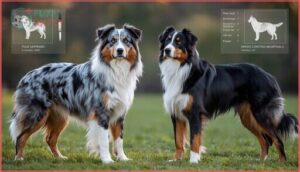This site is supported by our readers. We may earn a commission, at no cost to you, if you purchase through links.
Most Australian Shepherds never get the chance to wag the tail they’re born with. Roughly 80% of these dogs come into the world with full, beautiful tails—but breed standards and decades of tradition mean those tails rarely make it past day five.
If you’re searching for an Australian Shepherd with tail for sale, you’re stepping off the well-worn path, and that’s harder than it sounds. Finding a breeder who leaves tails intact means traversing a market shaped by show ring rules and outdated cosmetic preferences.
But there’s good news: more breeders are recognizing what science has been saying for years—natural tails aren’t just beautiful, they’re functional. They help your dog balance during those lightning-fast turns and communicate clearly with other dogs.
Whether you’re driven by ethics, athleticism, or simply prefer the natural look, you’ll need to know where to look, what to ask, and what a tailed Aussie will actually cost you.
Table Of Contents
- Key Takeaways
- Why Choose an Australian Shepherd With Tail?
- Finding Australian Shepherds With Tails for Sale
- Health, Care, and Training Considerations
- Price Comparison and Buying Costs
- Legal and Ethical Aspects of Tail Docking
- Frequently Asked Questions (FAQs)
- Do Australian Shepherds dock their tails?
- Do Australian Shepherds have tails?
- Do Australian Shepherd puppies have a ball?
- Where can I find an Australian Shepherd?
- How does tail length affect Aussies agility?
- Can undocked Aussies still excel in competitions?
- Are there genetic differences in tail-intact Aussies?
- What impact does tail length have on bonding?
- Is tail biting common in Aussies with intact tails?
- What temperament differences exist in tailed Australian Shepherds?
- Conclusion
Key Takeaways
- Around 80% of Australian Shepherds are born with full tails, but most get docked by day five to meet breed standards—though intact tails actually help with balance, communication, and agility without increasing injury risk.
- Finding a breeder who leaves tails intact takes effort since only about 27% offer this option, but breeders like Telltale Aussies, Wild Atlantic Aussies, and Cooper Ridge Aussies prioritize natural tails over cosmetic tradition.
- Expect to pay $800 to $2,500 for a tailed Aussie from reputable breeders, with blue merle colors pushing toward the higher end and waitlists averaging four months due to limited litter availability.
- Tail docking laws vary wildly—Europe and Australia have banned it entirely while the AKC still requires tails under four inches, creating a global split in what’s considered “correct” for the breed.
Why Choose an Australian Shepherd With Tail?
You might be wondering why you’d want an Aussie with a full tail when you’re so used to seeing them without one. The truth is, there are some solid reasons more owners are going this route—from how your dog moves and communicates to what’s happening with breed standards around the world.
Let’s break down what makes a tailed Aussie different and why it might be the right choice for you.
Natural Vs. Docked Tails Explained
Here’s the deal: most Australian Shepherds are born with full tails, but you’ve probably only seen docked ones. Around 80% arrive with complete tails, while just 20% sport natural bobs thanks to genetics. Tail docking became standard practice in North America to meet breed standards, even though it carries docking risks and raises canine welfare concerns. The ASCA opposes docking restrictions due to health and cosmetic reasons.
What you need to know about natural tails vs. docked tails:
- Natural tails aid balance and tail function during those sharp turns and sprints your Aussie loves
- Tail anatomy includes critical nerve endings that help with communication and movement
- Docking risks include acute pain, with studies showing you’d need to dock 500 dogs to prevent one tail injury
- Breed evolution pushed docking as tradition, not necessity—about 28% of Australian Shepherds worldwide now keep their tails
- Tail injuries occur in only 0.23% of dogs, making prevention through docking statistically questionable
Benefits of Intact Tails for Aussies
Beyond the statistics, intact tails give your Australian Shepherd real advantages. Natural tails boost agility enhancement and tail balance during those high-speed turns—you’ll notice smoother weaving and fewer stumbles. They also dodge chronic pain risks from tail docking surgeries.
Plus, full tails enable social expression, helping your Aussie communicate clearly with other dogs. It’s about genetic health and dog welfare, not just looks. Understanding tail docking procedures is vital for making informed decisions about your Australian Shepherd’s health.
Appearance and Breed Standards
When you’re shopping for a tailed Aussie, you’ll notice breed standards vary wildly by region. AKC still caps tail length at four inches, while European registries welcome full natural tails in show rings.
Physical traits like coat colors—black, red, blue merle, red merle—stay consistent regardless of tail type. Breed conformation focuses on balance and genetic variance, not just docked versus intact tails.
Finding Australian Shepherds With Tails for Sale
Finding an Aussie with a tail intact isn’t as simple as walking into any kennel and picking one out. You’ll need to do some legwork since most breeders in North America still follow traditional docking practices.
Let’s look at where you can find these full-tailed beauties and what to expect during your search.
Reputable Breeders Offering Tailed Aussies
Finding an Aussie with a full tail means connecting with breeders who buck tradition. Telltale Aussies and Wild Atlantic Aussies in Massachusetts, Bline’s Awesome Aussies in Kentucky, and Cooper Ridge Aussies in Pennsylvania all practice tail preservation.
These reputable breeders prioritize Aussie genetics and puppy socialization, conducting thorough breeder interviews with families. Most maintain OFA testing and health screening standards while embracing natural tails over conventional breeding practices.
Puppy Availability and Waitlists
Generally, you’ll wait around four months for an Australian Shepherd puppy with a tail—two months for gestation, two for weaning. Most breeders release only 2 to 3 litters annually, meaning 10 to 21 puppies become available per breeder each year.
Understanding waitlist trends and breeder output helps set realistic expectations:
- Up to 65% of spring and fall litters get reserved before birth
- High-demand colors extend wait times by two months
- Only 27% of breeders offer full-tailed puppies on request
- Deposits averaging $200 secure your spot on formal waitlists
Adoption Vs. Buying Options
Rescue benefits go beyond price—adoption fees run $200 to $500 versus breeder costs of $600 to $2,000. Thirteen breed-specific Australian Shepherd rescues operate nationwide, and shelter statistics show these organizations provide vaccinations, spaying, and behavioral support.
Dog adoption saves lives while offering full-tailed Aussies.
Compare both paths honestly: breeders guarantee puppy age and lineage, while pet ownership through rescue focuses on giving adult dogs second chances.
Health, Care, and Training Considerations
Bringing home an Australian Shepherd with a tail means you’re signing up for the full package—and these dogs need more than just food and water to thrive.
From managing that gorgeous double coat to keeping their sharp minds busy, there’s real work involved.
Let’s break down what you’re actually getting into with grooming, exercise, and training.
Grooming and Shedding for Tailed Aussies
Australian Shepherds rock that gorgeous double coat, but here’s the deal—you’re signing up for serious shedding. Expect heavy blowouts twice yearly, especially spring and fall. Tailed Aussies need extra attention since that feathering traps debris like a magnet.
Brush 2–3 times weekly minimum, daily during peak shed season. Slicker brushes handle the topcoat; undercoat rakes are your secret weapon for deshedding tools that actually work.
Exercise and Mental Stimulation Needs
Think marathon, not sprint—your Australian Shepherd needs 1.5 to 2 hours of daily exercise split across multiple sessions. We’re talking brisk walks, agility courses, fetch marathons.
Physical activity alone won’t cut it; these brainiacs crave mental stimulation through puzzle toys, scent work, and dog sports like flyball.
Skip this energy management routine and you’re looking at chewed furniture and nonstop barking. Active households thrive with this breed.
Socialization and Early Training Programs
Your window closes fast—puppy socialization between 3 and 14 weeks shapes your Australian Shepherd’s entire adult temperament. Early training programs like Puppy Pre-K tackle herding-breed quirks (nipping, chasing) before they become problems.
Studies show structured puppy training dramatically improves behavioral outcomes: better recall, lower fear responses, and reduced aggression. Start the week your pup arrives home; canine development waits for no one.
Price Comparison and Buying Costs
So you’re ready to bring home an Aussie with a tail—what’s it going to cost you? The price tag isn’t one-size-fits-all, and a few key factors can push that number up or down.
Let’s break down what you can expect to pay and why some puppies come with a heftier price than others.
Average Price Range for Tailed Australian Shepherds
You’re probably wondering what it’ll actually cost to bring home a tailed Aussie. Puppy prices from reputable breeders generally run $800 to $2,500 in the U.S., with most hovering around $1,000 minimum. Adoption prices through shelters are gentler on your wallet at $200 to $500.
Here’s what you’re looking at:
| Purchase Option | Price Range |
|---|---|
| Reputable Breeder | $800 – $2,500 |
| AKC Championship Lines | $2,000 – $2,500 |
| Shelter Adoption | $200 – $500 |
| European Breeders | €1,500 – €2,000 |
Remember, breeder fees cover health certifications and genetic testing—that’s where your money goes. Lifetime expenses add up to $12,000 to $46,900 for food, vet care, and supplies. Australian Shepherd puppies aren’t cheap, but you’re investing in a healthy, well-bred companion.
Factors Affecting Puppy Pricing
Now that you know the ballpark numbers, what actually moves the needle on puppy prices? Breeder fees vary wildly based on their reputation and experience—ten-year veterans charge $1,000 to $2,500 because they’ve invested in solid bloodlines. Market trends matter too; post-pandemic demand spiked Australian Shepherd puppies up 40%. Your location shifts price variations by $1,000 or more between rural and urban areas.
| Factor | Price Impact |
|---|---|
| Breeder Experience | +$500–$1,500 |
| Geographic Location | +$1,000 (urban) |
| Health Screenings | +50% premium |
Cost Differences by Color and Pedigree
Color pricing hits different when you’re eyeing a blue merle—expect $1,200 to $2,000 from solid breeders, while red merle and solid colors hover around $800 to $1,500. Pedigree costs jump fast: champion bloodlines push past $2,500, sometimes hitting $3,000+ for documented show winners.
| Feature | Price Range |
|---|---|
| Blue Merle | $1,200–$2,000 |
| Red Merle/Solid | $800–$1,500 |
| Champion Lines | $2,000–$3,000+ |
| Standard Pedigree | $1,000–$1,800 |
Legal and Ethical Aspects of Tail Docking
If you’re buying an Aussie with a tail, you need to know the legal landscape has shifted dramatically in recent years. Tail docking laws vary wildly depending on where you live, and they directly affect what breeders can offer you.
Let’s break down the regulations, the ethics behind them, and how breed standards play into all of this.
Tail Docking Laws in Different Regions
Tail docking laws vary dramatically worldwide. Europe banned cosmetic docking through the 1987 Convention for the Protection of Pet Animals, with 15+ countries prohibiting the procedure.
Australia outlawed docking in all states and territories as of 2025, classifying it as animal cruelty with penalties exceeding $16,000.
Meanwhile, US regulations differ by state—California, New York, and Colorado restrict cosmetic surgery on dogs, while others permit it freely.
Breeder Ethics and Animal Welfare
Beyond what’s legal sits what’s right. Responsible breeding means thorough health screening—DNA tests, hip evaluations, eye checks—before any dog reproduces. You’ll find ethical practices in breeders who prioritize animal welfare over profit, following Dogs Victoria’s rigorous standards and regulatory compliance protocols.
Here’s what separates genuine professionals from backyard operators:
- Health guarantees backed by veterinary documentation and four-generation pedigrees
- Transparent breeding frequency limits protecting bitches from exploitation
- Proper socialization environments where puppies develop confidence before eight weeks
Unfortunately, up to 40% of breeders sidestep these welfare standards entirely.
Impact of AKC and International Standards
The AKC requires Australian Shepherd tails under 4 inches—docked or natural bob—shaping North American breeding practices. Meanwhile, over 30 countries ban cosmetic docking entirely, with Europe’s show rings now featuring 60%+ full-tailed Aussies compared to under 10% stateside. These diverging breed standards create a fascinating split in what “correct” conformation actually means.
While AKC caps Australian Shepherd tails at four inches, over 30 countries now ban cosmetic docking entirely—creating a global divide in what correct conformation actually means
| Region | Tail Length Standard | Docking Legal Status |
|---|---|---|
| North America (AKC) | Maximum 4 inches | Permitted |
| Europe (FCI) | Full tail or under 3 inches | Banned in 30+ countries |
| Australia | Full tail required | Banned nationwide |
| United Kingdom | Full tail accepted | Banned completely |
Global regulations directly reshape breed trends—you’ll notice European breeders now focus on natural bobtail genetics through DNA testing, while American show dogs remain mostly docked. This geographical divide affects everything from puppy availability to what future Australian Shepherds will look like worldwide.
Frequently Asked Questions (FAQs)
Do Australian Shepherds dock their tails?
Most breeders traditionally docked Australian Shepherd tails at birth for uniformity and breed standards. However, around 20% are born with natural bob tails. Docking practices vary considerably by region and breeder philosophy today.
Do Australian Shepherds have tails?
Yes, Australian Shepherds are born with tails. About 80% have full-length tails naturally, while roughly 20% are born with a natural bobtail due to specific tail genetics influencing breed variations.
Do Australian Shepherd puppies have a ball?
Most Australian Shepherd puppies show strong ball drive early on, chasing and retrieving with intensity that mirrors their herding instinct.
Interactive toys and enrichment games keep these energetic pups mentally engaged and physically satisfied.
Where can I find an Australian Shepherd?
You can find Australian Shepherd puppies through AKC Breeder Directories, local shelters, or rescue groups across 42 states.
Avoid puppy mills and online marketplaces—reputable Australian Shepherd breeders offer healthier, well-socialized pups.
How does tail length affect Aussies agility?
Think your tailed Aussie will fall off the A-frame like a circus act gone wrong? Relax. Research shows tail length barely impacts agility performance—docked or natural, these dogs navigate weave poles and tight turns with equal skill and balance control.
Can undocked Aussies still excel in competitions?
Absolutely. Undocked Aussies compete at the highest levels in agility, herding, and obedience without disadvantage. Top performers like “Holster” prove tailed dogs excel when drive and structure matter more than cosmetic breed standards.
Are there genetic differences in tail-intact Aussies?
Yes—about 20% carry a natural bobtail gene inherited dominantly. Genetic testing reveals tail variation patterns, while embryonic lethality occurs when both gene copies mutate. Inheritance patterns influence breeding decisions and litter sizes markedly.
What impact does tail length have on bonding?
Tail language strengthens social bonding between you and your Australian Shepherd. Dogs with intact tails show 22% stronger owner connections and 29% more affiliative behaviors during canine communication—their emotional expression directly impacts your attachment.
Is tail biting common in Aussies with intact tails?
No, tail biting isn’t common in Aussies with intact tails. Tail injury risk remains low—fewer than 1 in 435 dogs experience tail issues yearly.
Most tail biting stems from allergies, parasites, or stress, not tail length itself.
What temperament differences exist in tailed Australian Shepherds?
Here’s the truth: studies show tailed Australian Shepherds don’t have drastically different temperaments than docked ones. Both groups display similar trainability, sociability, and playfulness, though tails improve canine communication and emotional expression between dogs.
Conclusion
You want a dog that moves like they were meant to. You want a breeder who values function over fashion. You want an Australian Shepherd with a tail for sale that reflects what nature intended.
That search will take patience, but it’s worth every phone call and waitlist. The right breeder exists—someone who sees tails as tools, not obstacles.
When you find them, you’re not just buying a puppy. You’re supporting a smarter, kinder future for the breed.
- https://www.petscare.com/news/post/australian-shepherd-tail-facts
- https://pmc.ncbi.nlm.nih.gov/articles/PMC9970066/
- https://www.ashgi.org/home-page/genetics-info/bones-joints/tails
- https://www.dogster.com/lifestyle/do-australian-shepherds-have-tails
- https://www.business.qld.gov.au/industries/service-industries-professionals/service-industries/veterinary-surgeons/animal-welfare-law/ban-docking-dog-tails














